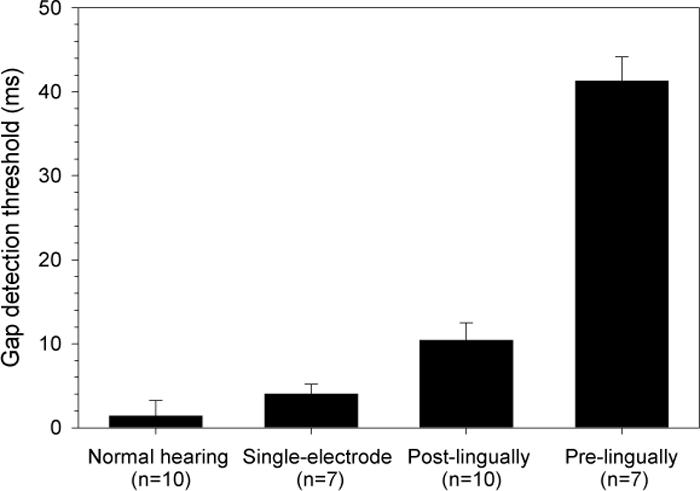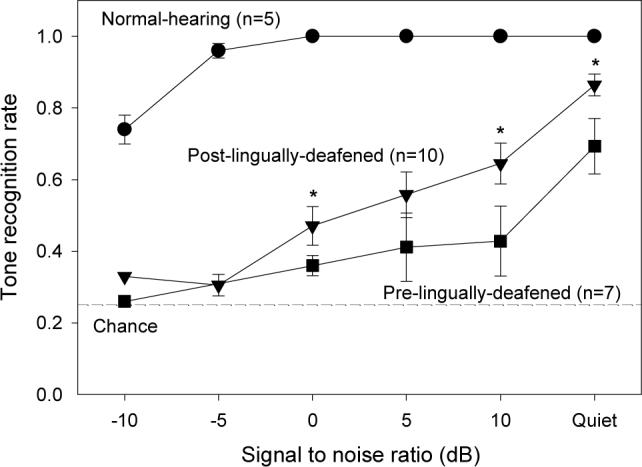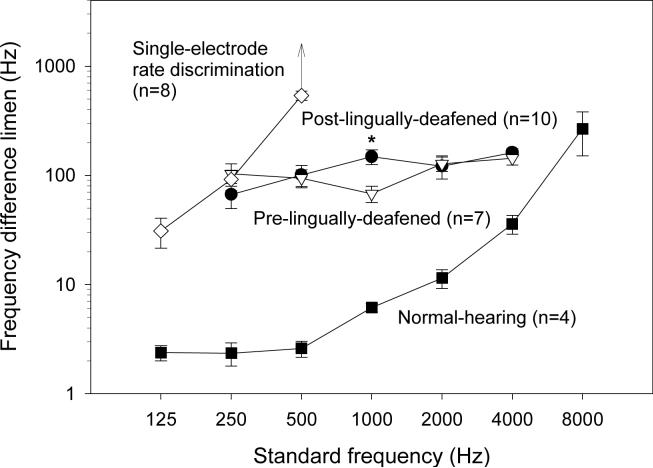Abstract
Objective
The present study was aimed to examine the relationship between psychophysical performance in temporal and spectral resolution and Mandarin tone recognition in noise by cochlear-implant (CI) listeners.
Design
Seventeen Nucleus-24 implant users, 10 post-lingually deafened and 7 pre-lingually deafened, participated in the experiments. A 3-interval, forced-choice procedure was used to measure gap detection and pure-tone frequency discrimination at 250 to 4,000 Hz in octave steps. A 4-alternative forced-choice procedure was used to measure Mandarin tone recognition in quiet and in noise. Signal-to-noise ratios (SNRs) varied from +10 to -10 dB. All stimuli were delivered to the clinical processor via a speaker in a sound free field. The obtained data were compared to data collected from normal-hearing control subjects, as well as cochlear-implant users who performed similar tasks using single-electrode stimulation via a research interface.
Results
Post-lingually deafened CI subjects generally performed better than pre-lingually deafened subjects. The average gap detection threshold was ~ 30 ms with a range from 4 to 128 ms. The average frequency difference limen was ~100 Hz with a range from 12 to 192 Hz, regardless of the standard frequency. The average tone recognition was 80% correct in quiet, which dropped to 55% at +10 dB SNR and essentially chance performance at -5 dB SNR. In comparison, the normal-hearing control subjects maintained essentially perfect performance over this SNR range. Only frequency discrimination at 1,000 Hz was significantly correlated with tone recognition in quiet but all psychophysical measures were correlated to tone recognition in noise.
Conclusions
The present result suggests that the CI users can rely on either temporal or spectral cues to perform tone recognition in quiet, but need both cues for tone recognition in noise. Future CI processors need to extract and encode these acoustic cues to achieve better performance in tone perception and production.
Keywords: Tone recognition, Mandarin tones, noise, gap detection, frequency discrimination, cochlear implant
The last decade has observed rapid development in cochlear implants in China, from essentially a non-existence of multi-channel CI users to more than 1,000 users today (Cao, 2004; Han, 2004; Zeng, 1995). A unique opportunity has arisen with this development to understand the acoustic cues in tonal languages and to extract and encode these cues in CIs. In general, current CIs cannot deliver satisfactory performance in tone recognition (e.g., Huang, Wang, & Liu, 1995; Lee, van Hasselt, Chiu, & Cheung, 2002; Wei, Cao, & Zeng, 2004). Poor tone perception, in turn, may have resulted in poor tone production, particularly in pre-lingually deafened children with CIs (Xu, Li, Hao, Chen, Xue, & Han, 2004).
The most salient cue for tone recognition is change in voice pitch, which is manifested acoustically by changes in fundamental frequency and its associated harmonics (Liang, 1963). Except for an obsolete version of the Nucleus device (Xu, Dowell, & Clark, 1987), current CIs do not explicitly extract and encode fundamental frequency information (Zeng, 1995). Current CIs rely on the less salient cue in the temporal envelope domain to encode tones (Fu, Zeng, Shannon, & Soli, 1998; Xu, Tsai, & Pfingst, 2002). To improve CI tone recognition, suggestions have been made to enhance the temporal envelope cue directly (Luo & Fu, 2004) as well as to encode the fundamental frequency explicitly (Lan, Nie, Gao, & Zeng, 2004) or implicitly by frequency modulation (Nie, Stickney, & Zeng, 2005).
To achieve better performance in CI tone recognition, we need to have a better understanding of the limiting factors in CI users and in CI processing strategies. The present study systematically measured psychophysical performance in gap detection and frequency discrimination in a group of Mandarin-speaking CI users. We then measured tone recognition in quiet and in noise in the same group of CI users to examine the relationship between temporal and spectral resolution and tone recognition.
METHODS
Subjects
Seventeen Nucleus-24 CI users participated in this study. There were 8 females and 9 males, with a mean age of 22 years old (ranging from 10 to 49). Ten of them were post-lingually deafened (>6 years old) and 7 were pre-lingually deafened. They all used the ACE processing strategy with MP1+2 stimulation. The average CI use was 18 months, ranging from 7 to 40.
Stimuli
Gap detection used a broad-band white noise, which had a 500-ms duration and a silent interval inserted in the temporal center of the noise (Zeng, Oba, Garde, Sininger, & Starr, 1999). Frequency discrimination used 200-ms pure-tones with standard frequencies from 250 to 4,000 Hz in octave steps (Zeng, Kong, Michalewski, & Starr, 2005). Mandarin tone recognition used the same 100-syllable tone list (25 CV combinations × 4 tones) as used in a previous study (Wei, Cao, & Zeng, 2004). The noise was spectrally-shaped to have the same long-term spectrum as the entire 100 syllables. All stimuli were presented at the most comfortable loudness level on an individual basis.
Procedure
An adaptive, 3-interval, forced-choice procedure was used in gap detection and frequency discrimination. The 2-down, 1-up decision rule was used to produce a 70.7% correct criterion for the threshold measure. A 4-interval, forced-choice procedure was used in tone recognition.
Both mixed-subject and within-subject designs were used to analyze the obtained data. The mixed-subject design was used to test whether there was a significant difference in performance between normal-hearing control and CI users, as well as between post-lingually and pre-lingually deafened CI users. The within subject design was used to test whether there was a significant difference between different frequencies and signal-to-noise ratios in the same group of subjects. A P-value less than 0.05 was deemed to be significant different.
RESULTS
Gap Detection
Normal-hearing listeners could detect a 2-ms gap, but all CI users required a significantly longer gap for detection, including a 4-, 10- and 41-ms gap for CI users with single-electrode stimulation, post-lingually, and pre-lingually deafened CI users, respectively. An independentsampled Student's t-test showed that all group differences were significant (p<0.05).
Frequency Discrimination
Normal-hearing subjects required a 2-3 Hz difference for standard frequencies at or below 500 Hz and an increasingly greater difference for standard frequencies at or above 1,000 Hz. With single-electrode stimulation, the CI users required a frequency difference that was 1-2 orders of magnitude poorer than normal-hearing subjects at 500 Hz and could not perform the task at standard frequencies above 500 Hz. With the clinical processor, the CI users performed similarly to those with single-electrode stimulation at 250 Hz but were able to discriminate a 100-Hz difference for standard frequencies up to 4,000 Hz. There was no difference in performance between the post- and pre-lingually deafened subjects [F(1,15)=1.4, p>0.05].
Tone Recognition
Normal-hearing subjects maintained nearly perfect performance, except for the 0.74 recognition rate at -10 dB SNR. In contrast, the ~0.7 recognition rate was the best the CI users could perform in quiet condition. The post-lingually deafened CI users performed significantly better than the pre-lingually deafened CI users [F(1,15)=5.2, p<0.05], but both groups produced basically chance performance at -10 and -5 dB SNRs.
DISCUSSION
Psychophysical Performance and Tone Recognition
Correlational analysis revealed several interesting findings. First, gap detection was significantly correlated with frequency discrimination at only 1,000 Hz (r=0.59, p<0.05) but was not correlated with tone recognition in noise. Second, only frequency discrimination at 1,000 Hz was significantly correlated with tone recognition in quiet (r=0.33, p<0.05). Third, as tone recognition became more difficult with noise, its performance was correlated with more psychophysical measures. For example, tone recognition at 10-dB SNR was significantly correlated with frequency discrimination at 500, 1,000, and 2,000 Hz (r=0.23-0.35, p<0.05); tone recognition at -5 dB SNR was significantly correlated with frequency discrimination at all frequencies from 250 Hz to 4,000 Hz, as well as with gap detection (r=0.21-0.61, p<0.05). The present result suggests that psychophysical measures are necessary but not sufficient to account for tone recognition. The present result also suggests that the cues for tone recognition are distributed: The CI users can choose to use any of them in relatively easy listening but have to rely on all available cues in difficult listening conditions.
Comparison with Previous Studies
Gap detection, rate discrimination, and electrode ranking of “place pitch” were measured extensively by single-electrode stimulation using a research interface in various CI populations (e.g., Nelson, Van Tasell, Schroder, Soli, & Levine, 1995; Shannon, 1989; Zeng, 2002). However, functional assessment of gap detection and frequency discrimination with the clinical processors was less often performed under controlled and comparable conditions. Typically, single-electrode stimulation measures patient variables, but functional assessment via clinical processors measures limitations posed by both electrical stimulation and the processing strategy.
For example, Shannon (1989) used single-electrode stimulation and found that there was generally <10 ms gap detection threshold in both Nucleus and Ineraid subjects. Tyler et al. (1989), on the other hand, used processors and found that many CI users had a gap detection threshold greater than 40 ms. On the contrary, many studies using single-electrode stimulation found the upper limit of frequency discrimination to be 300-500 Hz (e.g., Zeng, 2002), but studies using multi-channel processors, including the present one, have found relatively good frequency discrimination at high frequencies (e.g., Dorman, Smith, Smith, & Parkin, 1996)
Tone recognition in quiet in the present study was generally comparable to the previously reported results (e.g., Lee, van Hasselt, Chiu, & Cheung, 2002; Wei, Cao, & Zeng, 2004). Similar to previous results in relating psychophysical performance to speech performance (Dorman, Smith, Smith, & Parkin, 1996; Tyler, Moore, & Kuk, 1989), the present study showed that gap detection is weakly correlated, but frequency discrimination is significantly correlated with tone recognition. In addition, the present study showed that the more challenging the task (i.e., lower SNRs), the more frequencies at which frequency discrimination was correlated with tone recognition in noise.
SUMMARY
The present study systematically measured gap detection, frequency discrimination, and tone recognition in quiet and noise in 17 CI users. CI gap detection was significantly poorer than the normal-hearing control but was not correlated with tone recognition in quiet. CI frequency discrimination was also significantly poorer than in the normal-hearing control and was correlated with tone recognition in quiet only at 1,000 Hz. Both gap detection and frequency discrimination at other frequencies (250-4,000 Hz) became correlated with tone recognition in noise. The present result suggests that multiple acoustic cues may be used for tone recognition, particularly in more difficult listening situations such as the presence of noise.
Figure 1.

Gap detection threshold in 10 normal-hearing subjects (Zeng, Kong, Michalewski, & Starr, 2005), 7 cochlear-implant users who performed gap detection with single-electrode stimulation using a research interface (Zeng, unpublished data), 10 post-lingually-deafened and 7 pre-lingually deafened who performed the same task using their clinical processors. Error bars=1 standard error in all figures.
Figure 2.
Frequency discrimination as a function of standard frequency in 4 normal-hearing subjects (Zeng, Kong, Michalewski, & Starr, 2005), 8 cochlear-implant users who performed temporal rate discrimination on a single electrode (Zeng, 2002), 10 post-lingually-deafened and 7 pre-lingually deafened who performed pure-tone frequency discrimination using their clinical processors. Asterisks represent a significant difference between groups at the tested conditions.
Figure 3.

Mandarin tone recognition as a function of signal to noise ratio in 5 normal-hearing subjects (Kong & Zeng, 2006), 10 post-lingually-deafened and 7 pre-lingually deafened cochlear-implant users. Chance performance is 0.25. Asterisks represent a significant difference between groups at the tested conditions.
ACKNOWLEDGMENTS
We thank our cochlear-implant subjects for their time and dedication. This work was supported in part by Chinese NSF grant 39570756 (to K.C.) and NIH Grant 2 R01 DC02267 (F.G.Z).
REFERENCES
- Cao K. Standardization of cochlear implants. Chinese J Otorhinolaryngol. 2004;39(2):71–72. [Google Scholar]
- Dorman MF, Smith LM, Smith M, Parkin JL. Frequency discrimination and speech recognition by patients who use the Ineraid and continuous interleaved sampling cochlear-implant signal processors. J Acoust Soc Am. 1996;99(2):1174–1184. doi: 10.1121/1.414600. [DOI] [PubMed] [Google Scholar]
- Fu QJ, Zeng FG, Shannon RV, Soli SD. Importance of tonal envelope cues in Chinese speech recognition. J Acoust Soc Am. 1998;104(1):505–510. doi: 10.1121/1.423251. [DOI] [PubMed] [Google Scholar]
- Han DM. Current status of multi-electrode cochlear implants in China. Chinese J Otorhinolaryngol. 2004;39(2):70–71. [Google Scholar]
- Huang TS, Wang NM, Liu SY. Tone perception of Mandarin-speaking postlingually deaf implantees using the Nucleus 22-Channel Cochlear Mini System. Ann Otol Rhinol Laryngol Suppl. 1995;166:294–298. [PubMed] [Google Scholar]
- Kong YY, Zeng FG. Temporal and spectral cues in Mandarin tone recognition. J Acoust Soc Am. 2006;120(5 Pt 1):2830–2840. doi: 10.1121/1.2346009. [DOI] [PubMed] [Google Scholar]
- Lan N, Nie KB, Gao SK, Zeng FG. A novel speech-processing strategy incorporating tonal information for cochlear implants. IEEE Trans Biomed Eng. 2004;51(5):752–760. doi: 10.1109/TBME.2004.826597. [DOI] [PubMed] [Google Scholar]
- Lee KY, van Hasselt CA, Chiu SN, Cheung DM. Cantonese tone perception ability of cochlear implant children in comparison with normal-hearing children. Int J Pediatr Otorhinolaryngol. 2002;63(2):137–147. doi: 10.1016/s0165-5876(02)00005-8. [DOI] [PubMed] [Google Scholar]
- Liang ZA. Auditory perceptual cues in Mandarin tones. Acta Physiologica Sinica. 1963;26(2):85–91. [Google Scholar]
- Luo X, Fu QJ. Enhancing Chinese tone recognition by manipulating amplitude envelope: implications for cochlear implants. J Acoust Soc Am. 2004;116(6):3659–3667. doi: 10.1121/1.1783352. [DOI] [PubMed] [Google Scholar]
- Nelson DA, Van Tasell DJ, Schroder AC, Soli S, Levine S. Electrode ranking of “place pitch” and speech recognition in electrical hearing. J Acoust Soc Am. 1995;98(4):1987–1999. doi: 10.1121/1.413317. [DOI] [PubMed] [Google Scholar]
- Nie K, Stickney G, Zeng FG. Encoding frequency modulation to improve cochlear implant performance in noise. IEEE Trans Biomed Eng. 2005;52(1):64–73. doi: 10.1109/TBME.2004.839799. [DOI] [PubMed] [Google Scholar]
- Shannon RV. Detection of gaps in sinusoids and pulse trains by patients with cochlear implants. J Acoust Soc Am. 1989;85(6):2587–2592. doi: 10.1121/1.397753. [DOI] [PubMed] [Google Scholar]
- Tyler RS, Moore BC, Kuk FK. Performance of some of the better cochlear-implant patients. J Speech Hear Res. 1989;32(4):887–911. doi: 10.1044/jshr.3204.887. [DOI] [PubMed] [Google Scholar]
- Wei CG, Cao K, Zeng FG. Mandarin tone recognition in cochlear-implant subjects. Hear Res. 2004;197(12):87–95. doi: 10.1016/j.heares.2004.06.002. [DOI] [PubMed] [Google Scholar]
- Xu L, Li Y, Hao J, Chen X, Xue SA, Han D. Tone production in Mandarin-speaking children with cochlear implants: a preliminary study. Acta Otolaryngol. 2004;124(4):363–367. doi: 10.1080/00016480410016351. [DOI] [PubMed] [Google Scholar]
- Xu L, Tsai Y, Pfingst BE. Features of stimulation affecting tonal-speech perception: Implications for cochlear prostheses. J Acoust Soc Am. 2002;112(1):247–258. doi: 10.1121/1.1487843. [DOI] [PMC free article] [PubMed] [Google Scholar]
- Xu SA, Dowell RC, Clark GM. Results for Chinese and English in a multichannel cochlear implant patient. Ann Otol Rhinol Laryngol. 1987;96(suppl 128):126–127. [Google Scholar]
- Zeng FG. Cochlear implants in China. Audiology. 1995;34(2):61–75. doi: 10.3109/00206099509071899. [DOI] [PubMed] [Google Scholar]
- Zeng FG. Temporal pitch in electric hearing. Hear Res. 2002;174(12):101–106. doi: 10.1016/s0378-5955(02)00644-5. [DOI] [PubMed] [Google Scholar]
- Zeng FG, Kong YY, Michalewski HJ, Starr A. Perceptual consequences of disrupted auditory nerve activity. J Neurophysiol. 2005;93(6):3050–3063. doi: 10.1152/jn.00985.2004. [DOI] [PubMed] [Google Scholar]
- Zeng FG, Oba S, Garde S, Sininger Y, Starr A. Temporal and speech processing deficits in auditory neuropathy. Neuroreport. 1999;10(16):3429–3435. doi: 10.1097/00001756-199911080-00031. [DOI] [PubMed] [Google Scholar]



